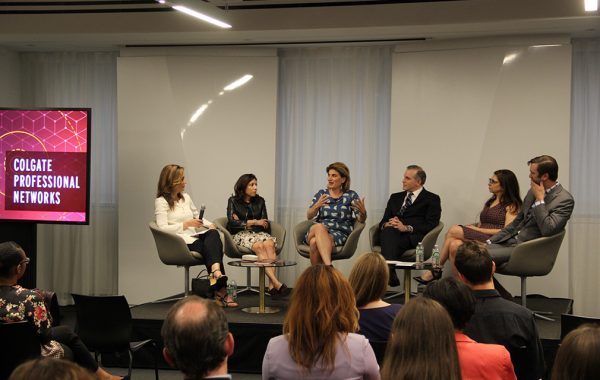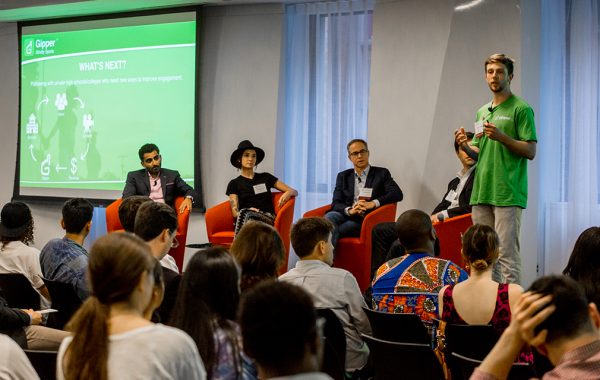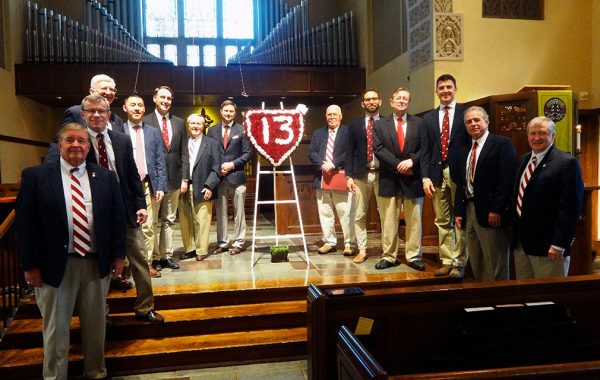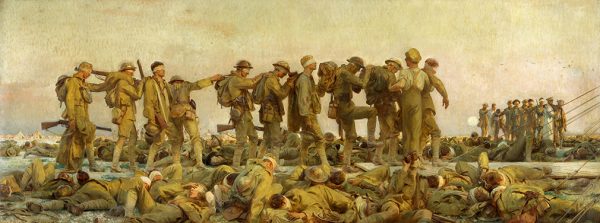The Office of Alumni Relations is pleased to offer many ways for alumni to stay in touch with each other, and with Colgate! E-mail me with questions or concerns at tmansfield@colgate.edu.— Tim Mansfield, associate vice president, institutional advancement and alumni relations.
Questions? Contact alumni relations: 315-228-7433 or alumni@colgate.edu

Left to right: Lisa Bernhard ’87, Carole Robinson ’83, P’18, Elisabeth Goodridge ’97, Jonathan Dienst ’90, Robin Garfield ’88, Christopher Guenther ’97
Alumni media panel: challenges facing journalism
In May, alumni and students convened in New York City to hear from some of the university’s leading members of the Fourth Estate. In a professional network panel conversation titled “The Challenges Facing Journalism in the Age of New Media,” alumni from Reuters, the New York Times, CNN, BuzzFeed, NBC, and News Corp delved into the challenges facing news organizations in the wake of a societal shift to online news consumption and the vast proliferation of social media.
“The overarching theme here is ‘where, ultimately, is the consumer going to land?’” Lisa Bernhard ’87, Thomson Reuters national journalist, asked the panel. “How do we monetize that, how do we stay in business, but also, how do we stay pure as well?”
At News Corp, where Christopher Guenther ’97 is senior vice president and global head of programmatic, the media company is constantly trying to understand ways to monetize content — but finds that to be more and more of a challenge since many of the platforms are not under the content creator’s control.
“If you go to our websites, that’s one way we can sell advertising,” Guenther said. “Then, people are sharing on Facebook, or on Google and Snap — if it’s on a platform you don’t control, it’s a challenge. How do you balance all that? How do you drive up revenue to support large news-gathering organizations?”
The New York Times, where Elisabeth Goodridge ’97 is a deputy editor, is now a subscription-first business that has added more than 300,000 in the first quarter of this year. The organization has been directing more efforts toward the way content appears on mobile phones and platforms like Facebook and Snapchat. Goodridge added that they have also been very cognizant of the need for information about this presidential administration. “So we have poured five million dollars into our Washington operation, hiring fact-checkers, data journalists, and investigative journalists to make sure we get the story out,” she said.
Jonathan Dienst ’90, chief investigative reporter at NBC 4 in New York City, said his job of finding a scoop, verifying that information, and getting it out first hasn’t changed much, but reporters are now increasingly gathering news from the public, thanks to the abundance of smartphones and the rise in social media usage.
“We have become increasingly dependent on the social media we receive from our viewers,” Dienst said. “Of course, we need to verify that and make sure it’s accurate; we don’t just throw things up on the newscast.”
Every organization represented on the dais relayed how they are now closely examining the ways in which the public shares and consumes news.
“We look at what people say when they share our content, and we put that into the development process,” said Carole Robinson ’83, P’18, chief communications officer at BuzzFeed. “For example, [food company] Tasty is one of our biggest brands. We know a lot about which Tasty videos have been shared the most and why. That’s direct data that we get from the audience.”
CNN is ramping up efforts to understand the audience by collecting data from its products, surveys, and focus groups.
“We’re looking, as we always have, at the motivation and behavior of viewers,” said Robin Garfield ’88, senior vice president of research and scheduling at CNN. “Because the platforms have multiplied — and in these times, the news cycle has sped up so much — everything has gotten more complex.”
Following the panel conversation, students, and parents gathered to network.

Matthew Glick ’19 presents his sports app Gipper during Entrepreneur Weekend. Photo by Lorenzo Ciniglio
Entrepreneur Weekend in NYC
During the sixth-annual Entrepreneur Weekend on April 29, student entrepreneurs pitched their ventures and gained business insights from notable alumni.
The New York City event featured a panel conversation moderated by Forbes magazine tech editor Steven Bertoni ’02. The panel included Samantha Radocchia ’11, co-founder and chief product officer of Chronicled, a blockchain and IoTfocused technology company; Cliff Sirlin ’89, co-founder of the Domino Media Group and now managing director at LaunchCapital LLC; and Ram Parimi ’05, cofounder and vice president of sales at the event-planning platform Social Tables.
The panelists started the conversation as advisers, offering insights into building a business after graduating from Colgate. Following a lively conversation, they took on the role of judges, critiquing venture pitches delivered by Thought Into Action (TIA) student entrepreneurs. The day also included the announcement of the Alumni Council’s 2017 Entrepreneur of the Year award winner, Oak Atkinson ’87, TIA mentor and founder of tumbalina, an artisanal card company.
Colgate University, TIA, and the Entrepreneur Professional Network hosted the event.

Colgate Thirteen alumni from six different eras gathered June 10 to honor one of their group’s founders, Bill MacIntosh ’44, who passed away on May 17.
Remembering a founding Thirteener
Colgate Thirteen alumni from six different eras gathered June 10 to honor one of their group’s founders, Bill MacIntosh ’44, who passed away on May 17.
Traveling from nine states to MacIntosh’s memorial service at the First Congregational Church of Western Springs, Ill., 13 Thirteeners sang the alma mater and the “Colgate Hymn.” The service also included words of remembrance from Bud Hedinger ’69 and Ed Hines ’63, two Thirteen alums who knew MacIntosh well.
A flower arrangement of maroon and white carnations in the shape of the Colgate Thirteen shield decorated the altar.
At the reception afterward, the group sang three more songs: “Great Day,” “Old Colgate,” and “Back in 1942,” sung to the music of “1819” but with new lyrics honoring MacIntosh and the founding Thirteen.
Forty-eight years separated the youngest member of this group, Felix Dai ’11, and the eldest, Hines. As they parted ways, members reflected on how special the day had been and agreed that the “spirit that is Colgate” has a unique and memorable quality.
Coast to coast with Calo
When Professor Mary Ann Calo leads museum tours for alumni-club members, she often sees familiar faces in the crowd. The tours she’s given so far this year were no different — many of the attendees were former students of Calo, the Batza Professor of art and art history emerita.
From January to May, she led tours of four exhibitions at museums across the country. Calo and alumni explored Frank Stella: A Retrospective at the de Young Museum in San Francisco; Seeing Nature at the Seattle Art Museum; WWI and American Art at the Pennsylvania Academy of the Fine Arts Museum in Philadelphia; and Matisse and American Art at the Montclair Art Museum in New Jersey.
At each of the museums, Calo and alumni engaged in stimulating conversations about the pieces on display. Of the four diverse exhibitions, Calo described WWI and American Art, which commemorates America’s entry into the war, as the most eye opening. One unusual piece the group encountered in the exhibition — an enormous painting titled Gassed by John Singer Sargent — depicts the victims of a poisonous gas attack in the trenches.
“I’ve never seen anything like it,” Calo said. “It’s worth going to the show just to see that painting.”
On the opposite coast, alumni who toured the Seattle Art Museum enjoyed viewing landscape paintings. Many were of Venice, Italy, where Calo will accompany a Colgate group in the fall. While the paintings all depict the same city, each differs due to the approach, style, and era of the artist.
If you missed this round of tours with Calo, don’t fret; she hopes to give a series of talks every year in museums across the country. In fact, future visits to museums in Boston and New York City are already in the works.
Hoping to draw interest from alumni and students alike, she added: “I hope that these events, in addition to providing opportunities for faculty-alumni engagement, also raise consciousness about the arts at Colgate.”
— Erin Burnett ’19







